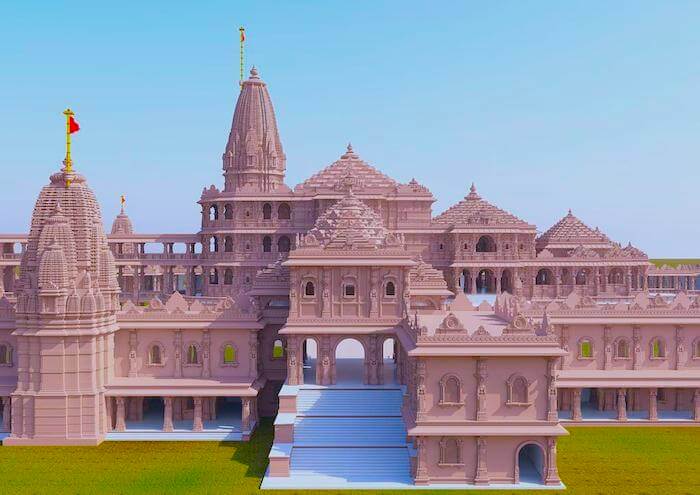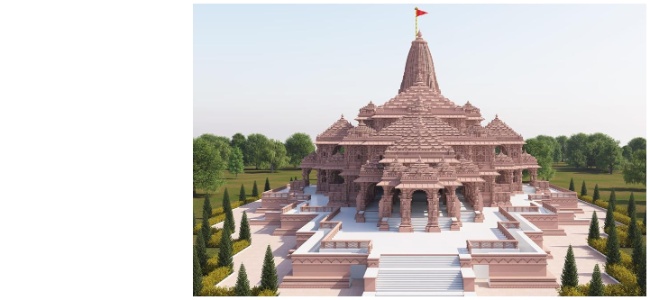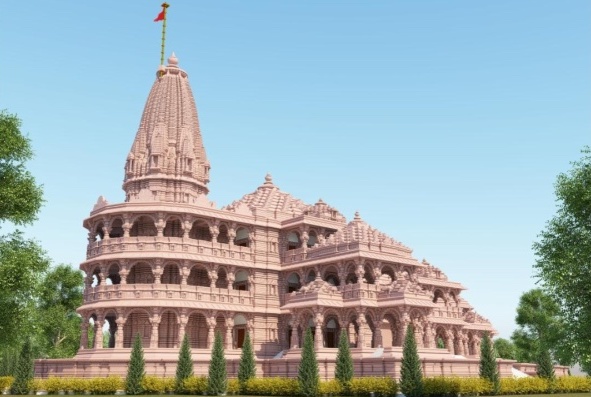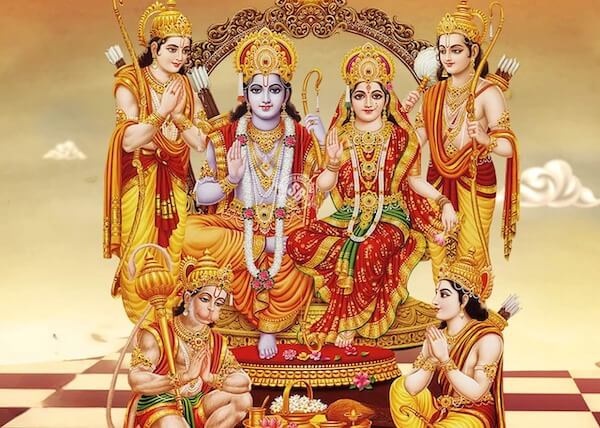Ayodhya, a city steeped in ancient history and spiritual significance, holds a special place in the hearts of millions as the birthplace of Lord Rama. The recent construction of the Ayodhya Ram Mandir marks a historic milestone, not just for the Hindu community, but for the entire nation. In this post, we delve into the interesting facts about Ayodhya Ram Mandir, shedding light on its historical, architectural, and cultural significance.
Table of Contents
About Lord Rama
Before delving into the fascinating facts about Ayodhya Ram Mandir, it is crucial to understand the significance of Lord Rama in Hinduism. Lord Rama, the seventh avatar of Lord Vishnu, is revered for his unwavering devotion to dharma (righteousness) and his exemplary conduct as a ruler, husband, and son. Because of these virtues, he is known as Maryada Purushottam. Born to King Dasharatha and Queen Kaushalya in Ayodhya, Lord Rama is often depicted with his loyal wife Sita, devoted brother Lakshmana, and the devoted devotee Hanuman.
Lord Rama’s rule, known as “Ram Rajya,” is the epitome of good governance and justice. His adherence to moral values, sense of duty, and compassion for all beings make him a revered figure in Hindu mythology. The Ramayana, an ancient Indian epic, narrates the life and adventures of Lord Rama, portraying him as a symbol of virtue and righteousness.
Ram Navami is a Hindu festival celebrated in honour of Lord Rama’s birth, which falls on the ninth day of Chaitra month in the Hindu calendar. Devotees commemorate this day with prayers, hymns, and processions, reflecting on the virtues of Lord Rama and his teachings.
Dussehra, also known as Vijayadashami, marks the triumph of good over evil, symbolizing Lord Rama’s victory over the demon king Ravana. Celebrated on the tenth day of the Hindu month of Ashvayuja, it involves the burning of effigies of Ravana, signifying the eradication of negativity and the triumph of righteousness. Both festivals, enriched with cultural traditions like Ramlila, hold immense significance in Hinduism.
Ayodhya Ram Mandir | Ram Janmabhoomi | Ram Temple Ayodhya

The Ayodhya Ram Mandir, an iconic symbol of India’s cultural and spiritual heritage, is dedicated to Lord Rama, the seventh avatar of Lord Vishnu, believed to have been born at this sacred site. Its construction marks a historic event following decades of the socio-political debate known as the Ram Janmabhoomi movement. Blending traditional Indian temple design with modern engineering, the temple stands as an architectural marvel, reflecting the nation’s rich heritage. The foundation stone laying ceremony in 2020, led by Prime Minister Narendra Modi, was a monumental occasion attended by millions.
Managed by the Shri Ram Janmabhoomi Teerth Kshetra Trust, the Ayodhya Ram Temple complex showcases intricate carvings and grand spires. The project gained global attention, emphasizing India’s diverse cultural and religious traditions. Embracing an eco-friendly construction approach with sustainable materials, the temple aligns with principles of environmental conservation. Its inclusive design welcomes people from all backgrounds, fostering a sense of unity and shared spirituality. The Ayodhya Ram Mandir holds immense emotional and religious significance, serving as a beacon of unity and pride for millions worldwide.
Interesting Facts about Ayodhya Ram Mandir | Unknown Facts about Ram Janmabhoomi Ram Mandir

Here are some unknown facts about Ram Temple Ayodhya. Delve into the mystique surrounding its construction and uncover the untold stories that enrich the tapestry of this sacred edifice.
- Historical Antiquity: The Ayodhya Ram Mandir’s history traces back to ancient times, with references in various scriptures and texts. Believed to be the birthplace of Lord Rama, Ayodhya has been a pilgrimage site for centuries. The current temple construction, inaugurated in 2020, continues a legacy that began with the birth of Lord Rama in the Treta Yuga.
- Architectural Marvel: The new Ayodhya Ram Mandir stands as an architectural marvel, blending traditional Indian temple architecture with modern engineering. The grandeur of the temple, with its intricate carvings and imposing spires, pays homage to the rich cultural and artistic heritage of India.
- Foundation Stone Laying Ceremony: The foundation stone laying ceremony of the Ayodhya Ram Mandir in August 2020 marked a historic moment for India. Prime Minister Narendra Modi laid the first stone, initiating the construction of the temple amidst jubilation and religious fervour.
- Ram Janmabhoomi Movement: The construction of the Ayodhya Ram Mandir is closely associated with the Ram Janmabhoomi movement, a socio-political campaign advocating for the recognition of the birthplace of Lord Rama. The movement spanned several decades and played a pivotal role in shaping India’s political landscape.
- Unity in Diversity: The construction of the Ayodhya Ram Mandir symbolizes the unity in diversity that is inherent in India’s cultural fabric. The project garnered support from people of various backgrounds, fostering a sense of national unity and pride.
- Shri Ram Janmabhoomi Teerth Kshetra: The Shri Ram Janmabhoomi Teerth Kshetra, established for the construction of the temple, is a trust responsible for overseeing the entire project. It operates to preserve and promote the spiritual and cultural heritage associated with Lord Rama.
- Donations and Contributions: The construction of the Ayodhya Ram Mandir received widespread support from devotees and well-wishers worldwide. The project was funded through voluntary donations, reflecting the deep emotional and religious connection people have with Lord Rama.
- Eco-friendly Construction: The Ayodhya Ram Temple construction emphasizes eco-friendly practices, incorporating sustainable materials and technologies. This approach aligns with the principles of environmental conservation, reflecting a harmonious balance between spirituality and nature.
- Global Recognition: The Ayodhya Ram Mandir has garnered global recognition, drawing attention to India’s rich cultural and religious heritage. Its significance extends beyond national boundaries, fostering a deeper understanding of Hinduism and its diverse traditions.
- Inclusive Design: The design and layout of the Ayodhya Ram Mandir aim to be inclusive, welcoming people from all walks of life. The temple complex features spaces for meditation, cultural events, and educational activities, promoting a holistic approach to spirituality.
- Largest Temple in India: The Ayodhya Ram Mandir stands as the largest temple in India, a testament to its grandeur and architectural magnificence. With towering spires and intricate carvings, it commands a majestic presence, attracting pilgrims and enthusiasts from across the globe.
- The Sacred Foundation: The temple’s foundation is not merely physical but carries deep spiritual significance. Constructed on the sacred land of Ayodhya, believed to be Lord Rama’s birthplace, every stone laid symbolizes a connection to ancient lore and divine roots.
- Soil from Thailand: To enhance cultural inclusivity, soil from Thailand was used in the construction, symbolizing a bond beyond borders. This gesture reflects the temple’s role as a symbol of global harmony and unity.
- No Iron or Steel Used: In a nod to ancient construction practices, no iron or steel has been used in the Ayodhya Ram Mandir. This traditional approach pays homage to historical building techniques, adding to the temple’s authenticity.
- ‘Shri Ram’ Bricks: The bricks used in the construction are inscribed with ‘Shri Ram,’ infusing the very building blocks with the divine name. Each brick carries not just physical weight but also spiritual significance, contributing to the sanctity of the structure.
- Contribution of Holy Rivers: Water from the sacred rivers of India, including the Ganges and Yamuna, was used in the construction. This infusion of holy water symbolizes purity and the convergence of divine energies.
- Nagara Style Architecture: The Ayodhya Ram Mandir follows the Nagara style of temple architecture, characterized by towering spires and intricate sculptures. This style, rooted in tradition, adds to the aesthetic appeal of the temple.
- Combining Shastras with Chaulukya Style: The temple seamlessly combines Vastu Shastra principles with the Chaulukya architectural style, showcasing a blend of ancient wisdom and artistic finesse.
- Lord Rama’s Durbar – Structure, Dome, Floors: Within the temple complex, the intricately designed Lord Rama’s Durbar stands as a testament to craftsmanship. The structure, dome, and floors showcase meticulous attention to detail, creating a sacred space for devotion.
- The Architects: The skilled architects behind the Ayodhya Ram Mandir’s construction are revered for their expertise and dedication. Their vision has translated into a structure that transcends time and resonates with spiritual energy. The chief architect of the Ayodhya Ram Mandir is Shri Chandrakant Sompura, whose family belong to the Sompura Salat community who are traditional temple builders. After Independence, when the Somnath Temple was being rebuilt, Chandrakant Sompura’s grandfather was given the task of planning and construction of the temple, by none other than Sardar Vallabhbhai Patel.
- Time Capsule: A time capsule was placed during the temple’s construction, preserving artefacts and messages for future generations. This modern touch adds an intriguing dimension to the temple’s historical legacy.
- Specialized Carvings: The temple boasts specialized carvings depicting episodes from the Ramayana and intricate detailing on pillars and walls. These carvings serve as a visual narrative, enriching the spiritual experience for visitors.
- Centre for Culture and Education: Beyond its religious significance, the Ayodhya Ram Mandir serves as a centre for cultural and educational activities. The Ayodhya Ram Mandir transcends its religious role to become a vibrant cultural and educational centre. It hosts events, seminars, and cultural programs that celebrate the diversity of India’s rich heritage, fostering an environment of learning and appreciation.
- Digital Documentation: The construction process and historical significance of the Ayodhya Ram Mandir have been digitally documented, ensuring that its legacy is preserved for future generations. This modern approach complements the timeless traditions embedded in the temple.
- Environmental Sustainability: The temple project emphasizes environmental sustainability, integrating eco-friendly practices in its construction and daily operations. From rainwater harvesting to energy-efficient systems, the Ayodhya Ram Mandir exemplifies a harmonious coexistence with nature.
- Interfaith Harmony Initiatives: To promote interfaith understanding, the Ayodhya Ram Mandir actively engages in initiatives that bring together followers of various religions. It stands as a beacon of unity, fostering dialogue and mutual respect among diverse communities.
- Inclusive Pilgrimage Facilities: The temple complex is designed with inclusive pilgrimage facilities, ensuring accessibility for people of all abilities. This commitment to inclusivity reflects the universal message of Lord Rama’s teachings.
- Renewable Energy Integration: Embracing modern technology, the Ayodhya Ram Mandir incorporates renewable energy sources, contributing to sustainability efforts. Solar panels and other eco-friendly innovations showcase a thoughtful approach to contemporary challenges.
- Socio-Economic Impact: Beyond its spiritual and cultural significance, the Ayodhya Ram Mandir project has a profound socio-economic impact. It generates employment, boosts local businesses, and contributes to the overall development of the region.
- Astrological Constellation Garden: Among the intriguing features of the Ayodhya Ram Mandir is a meticulously planned garden based on astrological constellations. This unique addition reflects a profound connection between spirituality and celestial influences, creating a serene space for contemplation within the temple complex. Incorporating a garden based on astrological constellations further enhances the Ayodhya Ram Mandir’s appeal as a holistic haven, where devotees and visitors can immerse themselves not only in the spiritual ambience but also in the harmonious alignment with the cosmos.
The Ayodhya Ram Temple in Ram Janmabhoomi stands as a testament to India’s cultural resilience and the enduring legacy of Lord Rama. Beyond being a religious edifice, it embodies the spirit of unity, faith, and the collective cultural consciousness of millions. The construction of the Ayodhya Ram Temple is a landmark event, not just for the Hindu community, but for the entire nation, showcasing the harmony between tradition and modernity. As the Ayodhya Ram Mandir continues to inspire devotion and admiration, it remains an iconic symbol of India’s rich spiritual heritage.
We trust you found delight in our exploration of the “Interesting Facts About Ayodhya Ram Mandir.” Share your experiences if Ayodhya has graced your travels; your thoughts are like gems in our treasure trove. Illuminate the lives of your dear ones by gifting them this collection of “Captivating Tidbits About Ram Janmabhoomi – Ayodhya Ram Temple.”
Embark on a metamorphic odyssey, guided by profound aphorisms and soulful connections. Take a seat at our extended family table; subscribe to our blog and newsletter. Here, a vibrant tapestry of wisdom awaits, weaving together threads of insight that cradle the spirit.
Stay linked, transcending the limitations of words; journey with us through Facebook, Instagram, X, Linkedin, and YouTube. Immerse yourself in every expedition, where enlightening quotes become compasses, and spiritual realms are unravelled.
Our monthly epistle, ‘Postcard From India,’ acts as your ticket to a carefully crafted repository of sagacity, cultural opulence, and contemplative musings. Engage actively in our pulsating social realms, carving your space as a cherished community member. Share your unique visions as you explore diverse cultures and be a part of our thriving WhatsApp community — a sanctuary for kindred souls celebrating the shared ardour for exploration.
In these connections, unfurl the genuine core of adventure, nurturing unity, embracing diversity, and plunging into the realms of spiritual inquiry. Seize this juncture to join a community that revels in the profound beauty encapsulated within life’s journey.
Also read:
- Top 15 Famous Sri Rama Temples In India
- Ram Navami Festival – Importance, Celebrations, Ram Temples
- 63 Best Instagram Captions for Ram Navami in English & Images
- Ram Navami Recipes – Naivedhya, Prasadam, Fasting Food
- 163 Best Jai Shree Ram Quotes In English, Hindi & Sanskrit
- 131 Best Hanuman Quotes In English & Hindi
We are a reader-supported site. This means, at no additional cost to you, we may earn a small commission if you book a flight or hotel, or make a purchase through one of our affiliate links. Thank you for your support!
Flights – Air India (Domestic) or Air India (International), or Priceline
Tours – Click to book top tours around the world. Book tours and activities here.
Experiences – Book your next unforgettable experience here, with flexible bookings and free cancellations. Reserve tours and activities now and pay later.
Hotels – Click to book the best hotels/resorts. Choose the best stay options with TripAdvisor or Hotels.com, or HotelsCombined
Travel Insurance – Click to book Travel Insurance that covers a range of travel insurance and safety services including medical emergencies, lost luggage, trip cancellation and more
Visas and Travel Documents Application – Click here for Online Travel Visa Check
Online Passport Photo – Get Your Passport Photo Online here

Do You Love Traveling?
Do you want to know how to travel the world? We have put together a very useful travel resources page with the best travel tips. Go check it out now. Thanks for visiting our site Voyager - imvoyager.com and taking the time to read this post! If you wish to collaborate/work with us then reach us at [email protected] We’d love it if you’d comment by sharing your thoughts on this post and share this post on social media and with your friends. Follow our journey on our social media channels: Facebook X Instagram Pinterest YouTube
Start dreaming about your next adventure with Tripadvisor. Book your next unforgettable experience here with flexible bookings and free cancellations.
Flight booking online at the best fare
60+ Million Users Trust TripAdvisor With Their Travel Plans. Shouldn't You?

Sandy & Vyjay are a husband and wife duo who are travel content creators. They are co-founders of this travel website and are one of the leading travel content creators in India.
Sandy & Vyjay quit their successful corporate careers to pursue their passion for travel and writing full-time. Their dedication has earned them the “Best Travel Writer” award and numerous accolades on both national and international stages. Focusing on India’s destinations, heritage, and culture, they are passionate advocates for nature and the environment. Through their content, they promote ecotourism and sustainable travel, inspiring others to explore and preserve the beauty of India.










This Ram Temple blog article delves into the historical, cultural, and religious significance surrounding the construction of the Ayodhya Ram Mandir, offering insights into the long-awaited fulfillment of a cherished aspiration for millions of devotees. It navigates the complexities of the temple’s journey, encapsulating the emotions, debates, and symbolic importance that define this monumental undertaking in India.
Sandy, this post beautifully captures the essence of Lord Rama’s significance in Hinduism. . The mention of festivals like Ram Navami and Dussehra adds a vibrant touch, showcasing how these cultural traditions uphold the virtues of Lord Rama. Truly an enlightening read on Ayodhya Ram Mandir and the rich heritage it symbolizes. Will definitely gonna share it with kids.
I’ve been hearing a lot about this huge temple. It’s great that people have come forward to contribute to its creation. I love ancient architecture and would love to go see this one day. Especially as it’s made the ancient way and no iron or steel was used.
Jai Shri Ram..!!!
Shri Ramachandra Prabhu is an icon of characteristics he owns and countless glories. Ram is undoubtedly an inspiration and bhagawan ram is someone who the entire world glorifies irrespective of the philosophy and caste/creed. Ram Lalla in Ayodhya is a gesture to Maryada Purushottam and your blog throws light on facts and enlightens those who aren’t aware of that information. Thanks for writing this detailed blog I am sharing this as much as possible. Let the heritage prevail and lets pledge to visit this iconic temple and experience the greatness and glory of Ayodhya, sarayu, and ram mandir.
Discovering 30 interesting facts about Ayodhya Ram Mandir was truly enlightening. It’s fascinating to see the blend of history, culture, and spirituality that surrounds this iconic temple.
Your exploration of 30 interesting facts about Ayodhya Ram Mandir is informative and engaging. The detailed insights provide a comprehensive understanding of the historical and cultural significance of this sacred site. The structured presentation makes it easy for readers to absorb the wealth of information you’ve compiled. Thanks for sharing these fascinating facts about Ayodhya Ram Mandir!
“Fascinating journey through Ayodhya’s rich history and the unveiling of the Ram Mandir! 🕌✨ Your detailed exploration of 30 interesting facts adds depth to the significance of this sacred place. The blend of historical insights and your personal experiences creates a captivating narrative. Thanks for taking us on this cultural adventure! 🌍🙏 #AyodhyaRamMandir #TravelHistory”